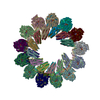+ Open data
Open data
- Basic information
Basic information
| Entry |  | |||||||||
|---|---|---|---|---|---|---|---|---|---|---|
| Title | Tomogram of bovine sperm singlet microtubules | |||||||||
 Map data Map data | Tomographic reconstruction of a bovine sperm flagellum tip. Striations of TAILS are visible along the microtubules. Reconstructed with IMOD package. | |||||||||
 Sample Sample |
| |||||||||
 Keywords Keywords | Flagella Cilia Microtubules Sperm / UNKNOWN FUNCTION | |||||||||
| Biological species |  | |||||||||
| Method | electron tomography / cryo EM | |||||||||
 Authors Authors | Hoog JL / Zabeo D / Croft JT | |||||||||
| Funding support |  Sweden, 2 items Sweden, 2 items
| |||||||||
 Citation Citation |  Journal: Proc Natl Acad Sci U S A / Year: 2022 Journal: Proc Natl Acad Sci U S A / Year: 2022Title: SPACA9 is a lumenal protein of human ciliary singlet and doublet microtubules. Authors: Miao Gui / Jacob T Croft / Davide Zabeo / Vajradhar Acharya / Justin M Kollman / Thomas Burgoyne / Johanna L Höög / Alan Brown /    Abstract: The cilium-centrosome complex contains triplet, doublet, and singlet microtubules. The lumenal surfaces of each microtubule within this diverse array are decorated by microtubule inner proteins ...The cilium-centrosome complex contains triplet, doublet, and singlet microtubules. The lumenal surfaces of each microtubule within this diverse array are decorated by microtubule inner proteins (MIPs). Here, we used single-particle cryo-electron microscopy methods to build atomic models of two types of human ciliary microtubule: the doublet microtubules of multiciliated respiratory cells and the distal singlet microtubules of monoflagellated human spermatozoa. We discover that SPACA9 is a polyspecific MIP capable of binding both microtubule types. SPACA9 forms intralumenal striations in the B tubule of respiratory doublet microtubules and noncontinuous spirals in sperm singlet microtubules. By acquiring new and reanalyzing previous cryo-electron tomography data, we show that SPACA9-like intralumenal striations are common features of different microtubule types in animal cilia. Our structures provide detailed references to help rationalize ciliopathy-causing mutations and position cryo-EM as a tool for the analysis of samples obtained directly from ciliopathy patients. | |||||||||
| History |
|
- Structure visualization
Structure visualization
| Supplemental images |
|---|
- Downloads & links
Downloads & links
-EMDB archive
| Map data |  emd_14723.map.gz emd_14723.map.gz | 2.8 GB |  EMDB map data format EMDB map data format | |
|---|---|---|---|---|
| Header (meta data) |  emd-14723-v30.xml emd-14723-v30.xml emd-14723.xml emd-14723.xml | 9.3 KB 9.3 KB | Display Display |  EMDB header EMDB header |
| Images |  emd_14723.png emd_14723.png | 257.1 KB | ||
| Filedesc metadata |  emd-14723.cif.gz emd-14723.cif.gz | 4 KB | ||
| Archive directory |  http://ftp.pdbj.org/pub/emdb/structures/EMD-14723 http://ftp.pdbj.org/pub/emdb/structures/EMD-14723 ftp://ftp.pdbj.org/pub/emdb/structures/EMD-14723 ftp://ftp.pdbj.org/pub/emdb/structures/EMD-14723 | HTTPS FTP |
-Validation report
| Summary document |  emd_14723_validation.pdf.gz emd_14723_validation.pdf.gz | 498.2 KB | Display |  EMDB validaton report EMDB validaton report |
|---|---|---|---|---|
| Full document |  emd_14723_full_validation.pdf.gz emd_14723_full_validation.pdf.gz | 497.8 KB | Display | |
| Data in XML |  emd_14723_validation.xml.gz emd_14723_validation.xml.gz | 5.1 KB | Display | |
| Data in CIF |  emd_14723_validation.cif.gz emd_14723_validation.cif.gz | 6.1 KB | Display | |
| Arichive directory |  https://ftp.pdbj.org/pub/emdb/validation_reports/EMD-14723 https://ftp.pdbj.org/pub/emdb/validation_reports/EMD-14723 ftp://ftp.pdbj.org/pub/emdb/validation_reports/EMD-14723 ftp://ftp.pdbj.org/pub/emdb/validation_reports/EMD-14723 | HTTPS FTP |
-Related structure data
- Links
Links
| EMDB pages |  EMDB (EBI/PDBe) / EMDB (EBI/PDBe) /  EMDataResource EMDataResource |
|---|
- Map
Map
| File |  Download / File: emd_14723.map.gz / Format: CCP4 / Size: 3.3 GB / Type: IMAGE STORED AS SIGNED BYTE Download / File: emd_14723.map.gz / Format: CCP4 / Size: 3.3 GB / Type: IMAGE STORED AS SIGNED BYTE | ||||||||||||||||||||
|---|---|---|---|---|---|---|---|---|---|---|---|---|---|---|---|---|---|---|---|---|---|
| Annotation | Tomographic reconstruction of a bovine sperm flagellum tip. Striations of TAILS are visible along the microtubules. Reconstructed with IMOD package. | ||||||||||||||||||||
| Voxel size | X=Y=Z: 4.37 Å | ||||||||||||||||||||
| Density |
| ||||||||||||||||||||
| Symmetry | Space group: 1 | ||||||||||||||||||||
| Details | EMDB XML:
|
-Supplemental data
- Sample components
Sample components
-Entire : Bovine sperm flagellum tip
| Entire | Name: Bovine sperm flagellum tip |
|---|---|
| Components |
|
-Supramolecule #1: Bovine sperm flagellum tip
| Supramolecule | Name: Bovine sperm flagellum tip / type: organelle_or_cellular_component / ID: 1 / Parent: 0 |
|---|---|
| Source (natural) | Organism:  |
-Experimental details
-Structure determination
| Method | cryo EM |
|---|---|
 Processing Processing | electron tomography |
| Aggregation state | cell |
- Sample preparation
Sample preparation
| Buffer | pH: 7.4 |
|---|---|
| Grid | Model: EMS Lacey Carbon / Material: COPPER / Mesh: 200 / Pretreatment - Type: GLOW DISCHARGE |
| Vitrification | Cryogen name: ETHANE / Chamber humidity: 100 % / Chamber temperature: 293 K |
| Details | The sperm cells were washed once in 1x PBS at 300x g for 8 minutes. |
| Sectioning | Other: NO SECTIONING |
- Electron microscopy
Electron microscopy
| Microscope | FEI TITAN KRIOS |
|---|---|
| Specialist optics | Energy filter - Name: GIF Bioquantum / Energy filter - Slit width: 20 eV |
| Image recording | Film or detector model: GATAN K2 QUANTUM (4k x 4k) / Detector mode: COUNTING / Average exposure time: 3.5 sec. / Average electron dose: 1.64 e/Å2 |
| Electron beam | Acceleration voltage: 300 kV / Electron source:  FIELD EMISSION GUN FIELD EMISSION GUN |
| Electron optics | C2 aperture diameter: 70.0 µm / Illumination mode: FLOOD BEAM / Imaging mode: BRIGHT FIELD / Cs: 2.7 mm / Nominal defocus max: 6.0 µm / Nominal defocus min: 4.0 µm / Nominal magnification: 33000 |
| Sample stage | Cooling holder cryogen: NITROGEN |
| Experimental equipment |  Model: Titan Krios / Image courtesy: FEI Company |
- Image processing
Image processing
| Final reconstruction | Algorithm: BACK PROJECTION / Number images used: 61 |
|---|
 Movie
Movie Controller
Controller











